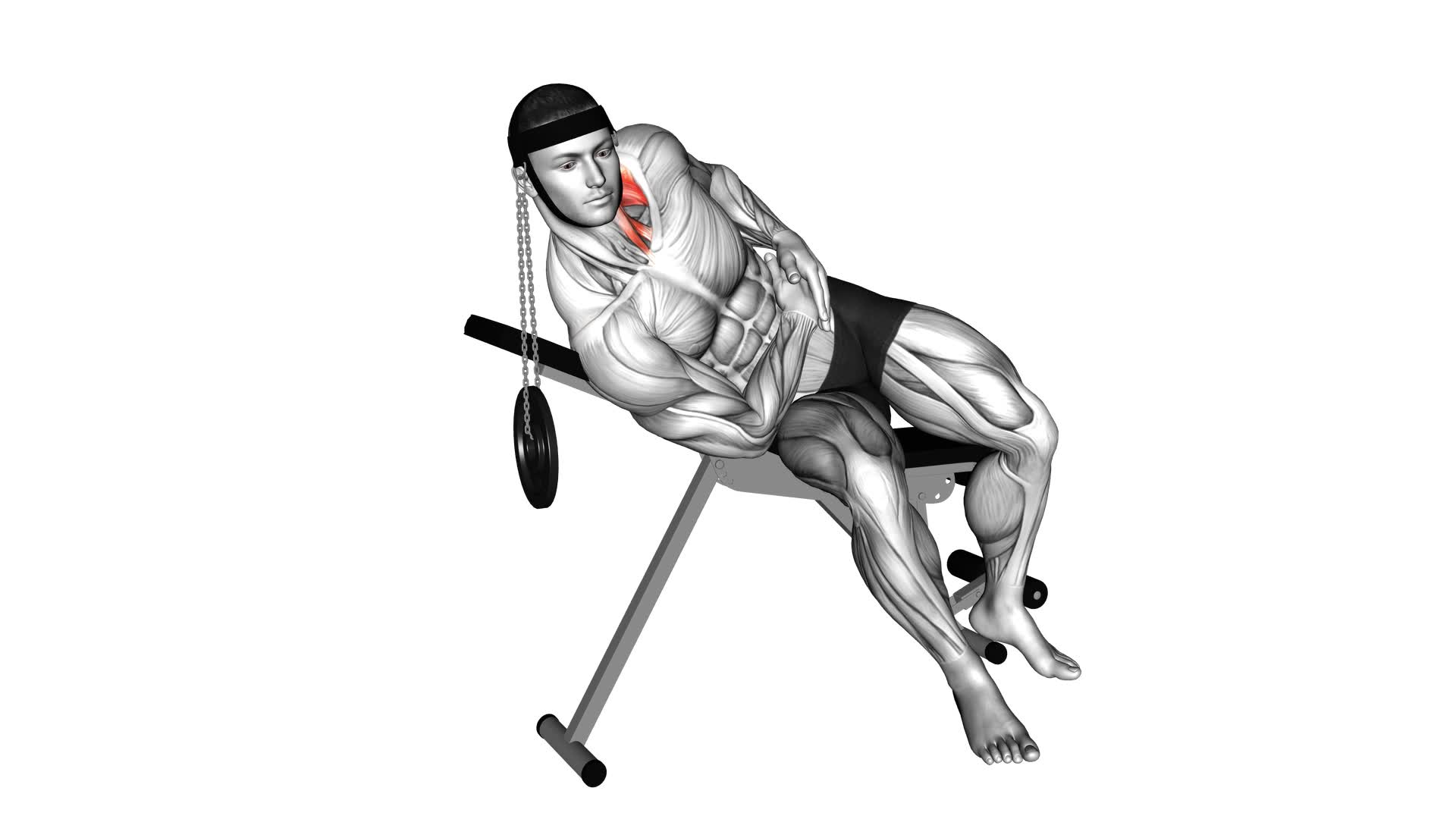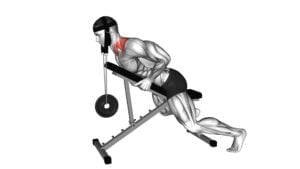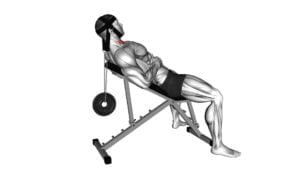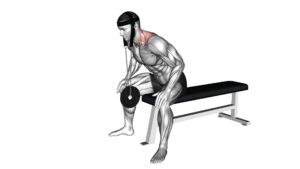Weighted Lying Side Lifting Head (With Head Harness) – Video Exercise Guide & Tips

In this guide, you'll learn all about the benefits, proper form, and common mistakes to avoid when doing the Weighted Lying Side Lifting Head exercise.
Watch This Exercise Video
With just a head harness and some weights, you can strengthen your neck and upper body.
Plus, we'll share tips to increase the intensity and safety precautions to keep in mind.
Get ready to take your workout to the next level with this effective exercise.
Let's get started!
Key Takeaways
- Weighted Lying Side Lifting Head exercise targets muscles in the neck and upper back.
- This exercise improves strength, stability, and posture.
- It can alleviate neck and shoulder pain and reduce the risk of injury.
- Alternatives to using a head harness for this exercise include resistance bands, towels, and dumbbells.
Benefits of Weighted Lying Side Lifting Head Exercise
You can experience a range of benefits from incorporating the weighted lying side lifting head exercise into your fitness routine. This exercise primarily targets the muscles in your neck and upper back, helping to improve strength and stability in those areas. By strengthening these muscles, you can alleviate neck and shoulder pain, improve your posture, and reduce the risk of injury in everyday activities.
One of the key benefits of this exercise is that it can help to prevent and alleviate neck pain. By strengthening the muscles in your neck, you can improve their ability to support your head and maintain proper alignment. This can help to reduce tension and strain, and alleviate discomfort.
Another benefit of the weighted lying side lifting head exercise is that it can improve your posture. By strengthening the muscles in your upper back and neck, you can improve your ability to maintain a neutral spine alignment, which is essential for good posture. This can help to reduce the risk of developing rounded shoulders and forward head posture.
There are also variations of this exercise that can target different muscles and add variety to your workout routine. For example, you can try lifting your head and shoulders off the ground while also lifting your legs, engaging your core muscles for an added challenge. You can also try using different types of weights, such as dumbbells or resistance bands, to increase the intensity of the exercise.
Incorporating the weighted lying side lifting head exercise into your fitness routine can have numerous benefits, including improved neck and upper back strength, pain relief, better posture, and the ability to target different muscles with variations. Consider adding this exercise to your routine to reap these benefits and enhance your overall fitness level.
Equipment Needed for Weighted Lying Side Lifting Head Exercise
To perform the Weighted Lying Side Lifting Head exercise, you'll need some essential equipment. The most important piece of equipment is a head harness, which will provide the necessary support and resistance for the exercise.
If you don't have a head harness, you can use alternative equipment such as a resistance band or a towel.
Essential Equipment for Exercise
To perform the Weighted Lying Side Lifting Head exercise, you'll need specific equipment.
The essential equipment for this exercise includes a head harness and weights.
The head harness is used to provide support and stability to your head and neck while performing the exercise. It ensures that your head stays in the correct position throughout the movement.
The weights are attached to the head harness to provide resistance and increase the intensity of the exercise. By using weights, you can challenge your neck muscles and improve their strength and endurance.
This exercise is beneficial for strengthening the muscles in your neck, improving posture, and reducing the risk of neck injuries.
Make sure to choose weights that are appropriate for your fitness level and always perform the exercise with proper form and technique.
Alternatives to Head Harness
What are some alternatives to the head harness for the Weighted Lying Side Lifting Head exercise?
If you don't have a head harness or prefer not to use one, there are other options available to strengthen your neck and upper body.
One alternative is to use a resistance band. Simply loop the resistance band around the back of your head and hold onto the ends with your hands. Then, perform the lying side lifting head exercise as you'd with a head harness.
Another option is to use a towel. Roll up a towel and place it behind your head, gripping the ends firmly with your hands. This will provide resistance as you lift your head to the side.
Proper Form and Technique for Weighted Lying Side Lifting Head Exercise
To perform the weighted lying side lifting head exercise with proper form and technique, it's important to focus on correct head positioning, breathing, and avoiding neck strain.
Keep your head in a neutral position throughout the movement, with your neck aligned with your spine.
Remember to breathe steadily and avoid holding your breath.
Also, be mindful of any strain on your neck and make adjustments as needed to maintain proper form and avoid injury.
Correct Head Positioning
When performing the Weighted Lying Side Lifting Head exercise with a head harness, ensure that you maintain correct head positioning throughout the movement. Proper head alignment and neck stability are crucial for maximizing the effectiveness of this exercise and preventing injury. Here are some key tips to help you achieve correct head positioning:
- Keep your head in a neutral position, aligning it with your spine.
- Avoid excessive tilting or rotating of your head.
- Engage your neck muscles to provide stability and support.
- Relax your jaw and keep your face muscles relaxed.
- Maintain a steady gaze, looking straight ahead throughout the exercise.
Following these guidelines will help you maintain proper form and technique, allowing you to safely and effectively target your neck and upper body muscles.
Remember to listen to your body and stop if you experience any pain or discomfort.
Breathing During Exercise
Maintain proper breathing technique while performing the Weighted Lying Side Lifting Head exercise with a head harness to ensure optimal form and effectiveness. Proper breathing during exercise is crucial for maximizing the benefits of the workout and preventing injury.
When performing the Weighted Lying Side Lifting Head exercise, focus on inhaling deeply through your nose before starting the lift. As you lift your head to the side, exhale slowly and steadily through your mouth. This controlled breathing pattern helps engage your core muscles and stabilize your body throughout the movement.
Remember to breathe consistently and avoid holding your breath, as this can lead to increased tension and decreased effectiveness of the exercise.
Incorporating proper breathing techniques into your routine will enhance your overall workout experience and help you achieve better results.
Avoiding Neck Strain
In order to avoid neck strain during the Weighted Lying Side Lifting Head exercise, focus on maintaining proper form and technique. Here are some tips to help you prevent neck strain and get the most out of your neck exercises:
- Keep your neck aligned with your spine throughout the exercise.
- Engage your core muscles to support your neck and upper body.
- Start with a light weight and gradually increase as you build strength.
- Avoid jerking or swinging motions, and instead, move in a controlled and smooth manner.
- Take breaks if you start to feel any discomfort or strain in your neck.
Common Mistakes to Avoid During Weighted Lying Side Lifting Head Exercise
To avoid injury during the Weighted Lying Side Lifting Head Exercise, it's crucial to focus on proper form and avoid rushing through the movement.
One of the most common mistakes people make is using too much weight. It's important to start with a lighter weight and gradually increase as you build strength and confidence. Using too much weight can lead to straining the neck and shoulders, which can result in discomfort or injury.
Another mistake to avoid is lifting the head too high. While it's important to engage the neck muscles, lifting the head too high can put unnecessary strain on the neck and lead to discomfort. Instead, focus on lifting the head just enough to engage the muscles without straining.
Additionally, it's important to maintain proper alignment throughout the exercise. This means keeping the neck and spine neutral and avoiding any twisting or rotating of the head.
Tips to Increase Intensity and Progression of Weighted Lying Side Lifting Head Exercise
To increase the intensity and progression of the Weighted Lying Side Lifting Head Exercise, you can incorporate various strategies. Here are some tips to help you increase the resistance and add advanced variations to your workout:
- Gradually increase the weight: Start with a light weight and gradually add more resistance as you become stronger. This will challenge your muscles and promote growth.
- Use a resistance band: Attach a resistance band to your head harness and perform the exercise. The band will provide constant tension throughout the movement, making it more challenging.
- Try unilateral movements: Instead of lifting both sides simultaneously, focus on one side at a time. This will put more emphasis on the targeted muscles and increase the difficulty of the exercise.
- Incorporate pauses and holds: Hold the lifted position for a few seconds before lowering your head back down. This will increase the time under tension and further engage your muscles.
- Experiment with different angles: Change the angle of the bench or the position of your body to target different areas of your neck and shoulders. This will provide a new stimulus to your muscles and enhance overall strength and stability.
Safety Precautions for Weighted Lying Side Lifting Head Exercise
To ensure your safety while performing the Weighted Lying Side Lifting Head Exercise, it's important to follow these precautions.
First and foremost, always consult with a healthcare professional or a qualified trainer before attempting this exercise, especially if you have any existing neck or spinal issues. They can provide guidance on whether this exercise is suitable for you and recommend alternatives if necessary.
When performing the Weighted Lying Side Lifting Head Exercise, it's crucial to use proper form and technique. Keep your neck and spine in a neutral position throughout the movement to avoid straining the muscles or causing injury. Avoid jerking or using excessive momentum, as this can put unnecessary stress on your neck and spine.
If you don't have access to a head harness, there are alternative options available. You can use a towel, resistance bands, or even hold a weight plate against your forehead to add resistance. Just make sure that whatever alternative you choose is secure and provides enough resistance to challenge your muscles without compromising your safety.
Lastly, listen to your body and start with a weight that's appropriate for your fitness level. Gradually increase the intensity of the exercise by adding small increments of weight or resistance over time. Remember, it's always better to start lighter and progress slowly than to risk injury by overloading your muscles too soon.
Frequently Asked Questions
How Much Weight Should I Start With When Doing the Weighted Lying Side Lifting Head Exercise?
When starting the weighted lying side lifting head exercise, it's important to choose an appropriate starting weight for your fitness level. Begin with a weight that challenges you, but still allows you to maintain proper form and control.
Starting with a lighter weight can help you focus on building strength and stability in your neck and shoulder muscles.
As you progress, gradually increase the weight to continue challenging your muscles and reaping the benefits of this weighted exercise.
Can I Perform the Weighted Lying Side Lifting Head Exercise Without a Head Harness?
Yes, you can perform the weighted lying side lifting head exercise without a head harness. However, it's important to note that using a head harness provides added support and stability during the exercise.
If you don't have a head harness, you can try alternative exercises such as neck curls or neck extensions to target the same muscles.
Remember to start with lighter weights and gradually increase as you build strength and comfort.
How Often Should I Incorporate the Weighted Lying Side Lifting Head Exercise Into My Workout Routine?
To effectively incorporate the weighted lying side lifting head exercise into your routine, consider the exercise benefits, proper form, and technique.
This exercise strengthens your neck muscles and improves posture. Start by lying on your side with a weight attached to your head. Lift your head against the resistance, keeping your neck straight and avoiding any jerking or swinging motions.
Aim to perform this exercise 2-3 times a week for optimal results.
Are There Any Alternative Exercises That Target the Same Muscles as the Weighted Lying Side Lifting Head Exercise?
Looking for alternative exercises that target the same muscles as the weighted lying side lifting head exercise?
There are a few options you can try. One alternative is the dumbbell lateral raise, which targets the shoulders and neck muscles.
Another option is the standing cable lateral raise, which also engages the same muscle groups.
Remember to consult with a professional to ensure proper form and technique when incorporating these alternative exercises into your routine.
Can the Weighted Lying Side Lifting Head Exercise Help Improve Posture?
Weighted lying side lifting head exercise can improve your posture. By incorporating head harness into your workouts, you can target the muscles responsible for maintaining proper alignment.
This exercise variation helps strengthen the neck, upper back, and shoulder muscles, which are crucial for good posture.
With regular practice, you can develop better posture and reduce the risk of postural imbalances or injuries.
Conclusion
In conclusion, the weighted lying side lifting head exercise is a beneficial workout that targets the neck and shoulder muscles.
It requires a head harness for added resistance and can be performed with proper form and technique to avoid common mistakes.
By following the tips provided, individuals can increase the intensity and progression of this exercise.
It's important to prioritize safety precautions while performing this exercise to prevent any potential injuries.

Author
Years ago, the spark of my life’s passion ignited in my mind the moment I stepped into the local gym for the first time. The inaugural bead of perspiration, the initial endeavor, the very first surge of endorphins, and a sense of pride that washed over me post-workout marked the beginning of my deep-seated interest in strength sports, fitness, and sports nutrition. This very curiosity blossomed rapidly into a profound fascination, propelling me to earn a Master’s degree in Physical Education from the Academy of Physical Education in Krakow, followed by a Sports Manager diploma from the Jagiellonian University. My journey of growth led me to gain more specialized qualifications, such as being a certified personal trainer with a focus on sports dietetics, a lifeguard, and an instructor for wellness and corrective gymnastics. Theoretical knowledge paired seamlessly with practical experience, reinforcing my belief that the transformation of individuals under my guidance was also a reflection of my personal growth. This belief holds true even today. Each day, I strive to push the boundaries and explore new realms. These realms gently elevate me to greater heights. The unique combination of passion for my field and the continuous quest for growth fuels my drive to break new ground.







